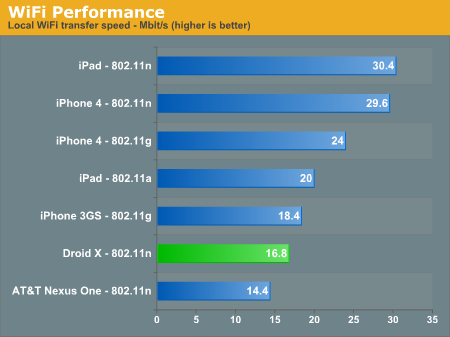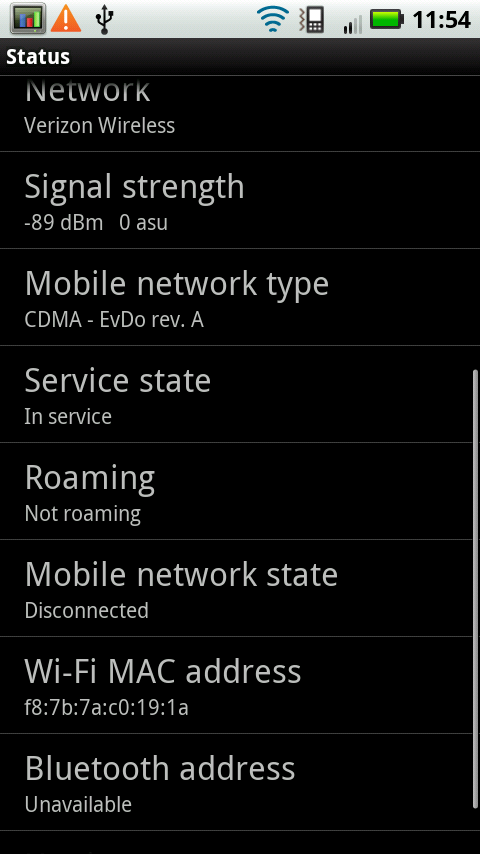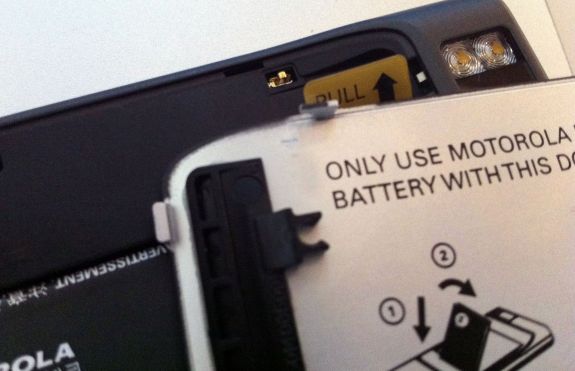Motorola Droid X: Thoroughly Reviewed
by Brian Klug on July 20, 2010 4:27 PM EST- Posted in
- Smartphones
- Motorola Droid X
- OMAP
- Mobile
Connectivity
The X supports CDMA 800/1900 and Ev-DO Revision A for data. There’s also Bluetooth 2.1+EDR, and WiFi 802.11g/n. I did notice N working at 72 megabits/s which seems to be the standard negotiated N connection speed for smartphones lately.
I’m somewhat of a speedtest freak, and I’ve run just shy of 100 speedtests on the X over cellular data. My average downstream speed has come to 0.91 megabits/s, upload is 0.73 megabits/s. This is completely on par with what I’d expect from CDMA 200 Ev-DO Rev.A networks. Though it isn’t anything special, I give the X credit for performing up to par, especially considering the number of... erm... devices that are shipping with some variety of radio problem.
Unfortunately, I did experience a lot of disconnections when connecting to N wireless networks. Searching online, a lot of people seem to be experiencing the same issue. Initially this posed a big problem for our WiFi page loading battery life benchmark, as I had to keep checking every 10 minutes to see if the phone was still connected. Later, I tried connecting to my WRT54G-TM running tomato (802.11g) and completed the test with a solid connection.
Later, I ran my WiFi throughput tests and noticed that the connection would drop on 802.11n whenever throughput started to go very fast, as it approached real N rates on my network. I switched back and forth between a WRT600N and latest generation Airport Extreme - both elicited the same behavior. The connection would drop, and sometimes not resume until I manually turned WiFi off and back on. This is very similar to some of the connectivity issues I’ve experienced with immature 802.11n stacks on the desktop, or due to chipset incompatibilities. Connecting to 802.11g, I was able to hold a solid connection without trouble.
Clearly the problem seems to be with the WiFi stack when connected to 802.11n networks. Hopefully this will be corrected in the future with some software update. There were rumors that this would be fixed with the July 19th update to 1.13.604 - it seems that review units were pushed this update a week early, as I saw it a while ago. WiFi still drops and reconnects periodically even running this version of the software and baseband.
Throughput on the X while downloading a 100 MB PDF stored locally was 16.8 megabits/s.

I also noticed that the X has longer wireless range than the EVO. I’ve been asked in the past to test wireless range - the X, Nexus One, and iPhone 4 I had on hand all kept stable WiFi connections to roughly the same distance.
Cellular Antennas
There’s also been a bit of discussion lately about the X’s diversity antenna configuration. If nothing else, the iPhone 4 antenna controversy has drawn attention to the fact that attenuation due to the composition of your hand happens on all devices.

Getting signal strength in dBm on Android is as easy as about -> status. Or a documented dialer code.
So how does the X fare? I saw a worst case drop of 15 dB on the X, cupping it tightly death grip style. I had an original Droid side by side and saw the same signal (-89 dBm at my house), so reception without holding the phone is unscientifically the same. The X drops signal about the same amount of signal due to attenuation from your hand being in the way as every other smartphone with an internal antenna. 15 dB is completely typical.
| Signal Attenuation Comparison in dB - Lower is Better | |||||||
| Cupping Tightly | Holding Naturally | On an Open Palm | Holding Naturally Inside Case | ||||
| Droid X | 15.0 | 5.1 | 4.5 | NA | |||
| iPhone 4 | 24.6 | 19.8 | 9.2 | 7.2 | |||
| iPhone 3GS | 14.3 | 1.9 | 0.2 | 3.2 | |||
| HTC Nexus One | 17.7 | 10.7 | 6.7 | 7.7 | |||
I’m not entirely sure what’s going on with the X’s spatially diverse antennas - I could make signal drop when holding the bottom of the phone, which is standard placement area for smartphone antennas these days, yet no drop happened when I cupped the top half tightly. I’m not saying definitively that there isn’t spatial diversity for the cellular antenna, just that I could never see evidence of it in the numbers. Perhaps Motorola is doing something much more subtle, or the value being reported in Field Trial is only for the bottom antenna - it’s entirely possible that the reporting I saw in the Field Trial and About -> Status doesn't reflect what the baseband is seeing.
I noticed something else curious and briefly made mention of it before. On the back of the phone under the battery door, there’s a gold contact that makes contact with the battery door. There are also three metal connectors that make contact with the tabs that lock the door in place.
Is the X pulling an iPhone 4 with creative antenna design? It seems possible, though I’m not sure what it’s being used for. WiFi signal strength is the same with the battery door on and off, as is cellular, and GPS. It also isn’t being used to tell if the door is on or not, as the device works the same with it on or off. Perhaps this is just for grounding.











89 Comments
View All Comments
homebredcorgi - Tuesday, July 20, 2010 - link
Who do we have to blame for the “Droid” moniker? Verizon or Motorola?I have a Nexus One and continually get asked, “Is that a Droid?” or “Does that run Droid?” to which I usually reply yes and let sleeping dogs lie…but seriously, why name it so similar to the operating system? And then why make “Droid” a series of phones if your first phone is just known simply as “Droid”?! At least call it the "Droid One" or something to differentiate from the series of phones....
So now we have the Droid, Droid Eris, Droid X, and will soon have the Droid 2 which are all phones in the Droid series, all running on various builds of Android. Yeesh. Could they have made that any more confusing?
All in all, the Droid X looks very nice. I personally think the original Droid had all the flair of a TI-82 calculator (ugly as sin in a blocky retro way), but the Droid X seems to have modernized its looks. Still not sure if I would want a phone that large though….
metafor - Tuesday, July 20, 2010 - link
Verizon owns the rights to the "Droid" trademark from Star Wars. So they decided to capitalize on that and name their whole line of Android phones "Droids".I think it's kinda cheezy but hey, it's selling and is something that people can focus on. With the army of phones coming out every week, it's difficult for the average person to keep up. It helps if they can just go to a store and ask for a Droid.
strikeback03 - Tuesday, July 27, 2010 - link
Actually they have only been using Droid on the high-end phones, the Devour and Ally were not Droids.There is also rumor of a special edition Droid 2 coming with R2-D2 on the battery cover...
lewchenko74 - Tuesday, July 20, 2010 - link
The best, most comprehensive review of the Droid X Ive read so far. Thank you.Just got to wait until it arrives in the UK unlocked now, but personally I think Im going to get the Droid 2 instead with the keyboard.
I am amazed at the pace the smartphone market is moving at. Im 1yr into a 2yr contract with a HTC Hero. It feels like an antique! These 2yr contracts really are a ball and chain.
It also seems like HTC is starting to lag behind Samsung and Moto now in terms of processor and features. Sense also seems a little 'old' compared to other UI layers (or maybe thats just me).
Disappointed that it only runs Android 2.1 when 2.2 is now out though.... That would be like Apple releasing iPhone4 running OS3.2 whilst saying OS4 is out there too but not quite available yet! (I guess Apple actually did that though with the iPad ;-) )
mvmorr01 - Tuesday, July 20, 2010 - link
What app are you using for those CPU utilization graphs? I did a quick search and couldn't find it in the market.Brian Klug - Tuesday, July 20, 2010 - link
It's an application called "SystemPanel" which I found a while back. If you turn logging on, it'll give you some very cool graphs of battery use over time and CPU utilization over days even. Produces some very cool results when I do battery life testing.-Brian
529th - Tuesday, July 20, 2010 - link
First of all I want to say I love mine! :) Bought it the day it came out.Wow what a great review!!!
I didn't know you could run benchmarks on a phone! Linpack!?? WOW awesome!
I can't wait till Froyo! :)
Thanks again chief!
<3 Anandtech reviews!
WaltFrench - Saturday, July 24, 2010 - link
Linpack is a 90s-era benchmark that performs a specific matrix solution. As much as possible, all floating point adds and muls.I've tried in other forums to find an app, prior to 6/1/2010, that actually uses Gaussian elimination with partial pivoting. The particular method works best to find complex patterns within large data sets; that's great for my statistical investment models and for a lot of other stuff. It's strongly suggestive of performance on weather simulations, quantum chemistry, etc., stuff that no sane person would attempt (today) on a smartphone.
Others claim Linpack scores around 40 on overclocked ARM chips with Froyo (the JITting being fabulously helpful for highly repetitive benchmark code). I got ~35 on my iPhone. These scores are ~ 13X–16X what the Linpack author quoted long ago for his 486 (/487, I presume).
I don't know a lot about graphics but presume 3D work that calls for lots of floating point Add/Mul work would get routed to the GPU, so I think these scores are of extremely limited relevance to any smartphone app I can envision.
vshin - Tuesday, July 20, 2010 - link
Where are the antenna attenuation tests? No weak spots?Brian Klug - Tuesday, July 20, 2010 - link
There's definitely attenuation tests in there, and weak spots. The bottom of the phone as expected causes a 15 dB drop. It's on page 14: http://www.anandtech.com/show/3826/motorola-droid-...-Brian